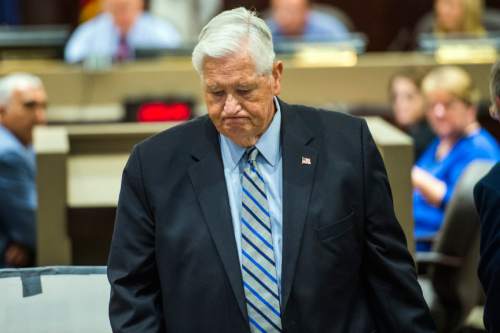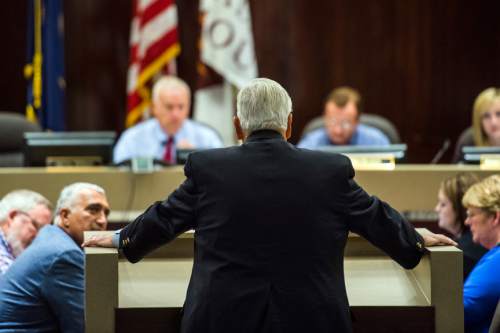This is an archived article that was published on sltrib.com in 2015, and information in the article may be outdated. It is provided only for personal research purposes and may not be reprinted.
Shoppers in Salt Lake County pay among the highest sales tax rates in the state — largely because of extra tax to fund the Utah Transit Authority. Proposition 1 may soon widen the disparity if voters approve it.
Here's a demonstration of what the expanded difference could mean.
Prop 1 would raise taxes by a penny for every $4 in purchases to improve mass transit and roads. It sounds small, but it would add $84 to the cost of a typical new car — which Kelley Blue Book now says averages $33,560 in America.
If Salt Lake County approves Prop 1 while many lower-tax areas do not put it on their ballot, it could make that typical new car cost $386 more in Salt Lake County than in most rural areas.
Legislators worried aloud about that when they debated a bill to allow Prop 1 this year, saying it could lead some Utahns to shop for big-ticket items such as cars in areas where the tax hike is not considered or passed. But the Utah Association of Counties assured them that a vast majority of counties planned to put it on the ballot.
So far, 17 of 29 counties have done that — including Salt Lake County and all large Wasatch Front counties.
The sales tax rate in most Salt Lake County areas is now 6.85 cents per dollar in purchases (except in Alta, Murray and South Salt Lake, where rates are higher), according to Utah Tax Commission data.
Prop 1 would raise that to 7.1 cents per dollar. (That would still be less than current average combined sales tax rates in 21 states, according to Tax Foundation data.)
The median for all sales tax rates in Utah now is 6.3 cents per dollar, according to a Tribune analysis of tax commission data. Statewide, rates range from 8.35 cents per dollar in Alta (which adds resort-area taxes) to 5.95 cents in most rural areas .
The main reason sales taxes are higher in Salt Lake County is that it charges extra to help fund the Utah Transit Authority and its bus and rail systems. The rate for UTA there is 0.6875 percent, just over two-thirds of a cent per dollar in purchases.
Other counties in the UTA district have chosen to pay less for mass transit. Davis, Weber and Box Elder counties pay 0.55 percent; Utah County pays 0.526 percent; and Tooele County pays 0.3 percent.
UTA says it works to ensure that its spending in each county roughly matches revenue raised there — so Salt Lake County receives more services for its higher taxes.
Forty percent of new Prop 1 money would go to mass transit in counties that have transit agencies such as UTA. Another 40 percent would go to cities for roads, and 10 percent would go to counties. In counties without a transit agency, counties would receive the transit slice of money.
So Prop 1 would raise taxes for UTA in Salt Lake County to 0.7875 percent, up an extra tenth of a penny per dollar, or a 14.5 percent increase in UTA taxes there.
If all six counties served by UTA pass Prop 1, that agency has said it figures that would increase its revenues by about 13 percent — or $39 million a year. Its board has vowed to use the extra money mostly to expand bus service, including more at night and on weekends.
Spending for the sometimes-controversial UTA has fueled some opposition to Prop 1.
For example, Evelyn Everton, Utah director for Americans for Prosperity, has said if UTA's "past is anything like the future, we know this money will not be spent on bus service, but instead will be spent on lavish trips and five-figure bonuses to top executives. I trust that voters will see through their rhetoric."
Some leaders in Salt Lake and Utah counties voted against putting Prop 1 on the ballot this year worrying that attacks on UTA could kill the overall tax hike, and suggested delaying and asking the Legislature to allow separate votes on tax hikes for UTA and local roads.
Prop 1 supporters note that 111 cities have passed resolutions statewide saying it is needed. They say the state did not raise gasoline tax for 18 years (although it will rise by 5 cents a gallon on Jan. 1), which led to a large road maintenance backlog. Local governments receive a third of state gasoline taxes.
Passing Prop 1 "is the conservative thing to do," Weber County Commissioner Kerry Gibson said at an event promoting the tax increase last week. "This is the right thing to do, to pay our bills as we go, to pay them upfront when we can to make sure we are not passing that burden on to our children."
"I can attest to the dire need for transportation funding," Orem Mayor Richard Brunst said at the same event. "Current funding levels are not adequate," especially with the population expected to skyrocket in coming years.
Of note, Prop 1 would not affect the sales tax on food, said Jim Clayton, sales tax distribution manager for the Utah Tax Commission. That is set at 3 percent. State law gives 1.75 percent of the food tax to the state, 1 percent to cities and 0.25 percent to counties. —
On the ballot
Counties putting Propositon 1 on their ballots include:
Beaver
Box Elder
Carbon
Davis
Duchesne
Grand
Juab
Morgan
Rich
Salt Lake
San Juan
Sanpete
Sevier
Tooele
Utah
Uintah
Weber
Source: Utahns for Responsible Transportation Investment. —
Where Salt Lake County sales tax dollars go
Jim Clayton, sales tax distribution manager for the Utah Tax Commission, offers this breakdown of where the $1.42 billion raised through the Salt Lake County sales tax was spent in the last fiscal year.
$992.4 million • or 69.8 percent, went to the state general fund.
$214.6 million • or 15.1 percent, went to cities or the unincorporated county.
About $141.1 million • or 9.9 percent, was paid in "mass transit" taxes (part of which is diverted to the Utah Department of Transportation for area road projects).
$52.5 million • or 3.7 percent, went to the county.
$2.8 million • or 1.4 percent, went to a tax for zoos, arts and parks.





